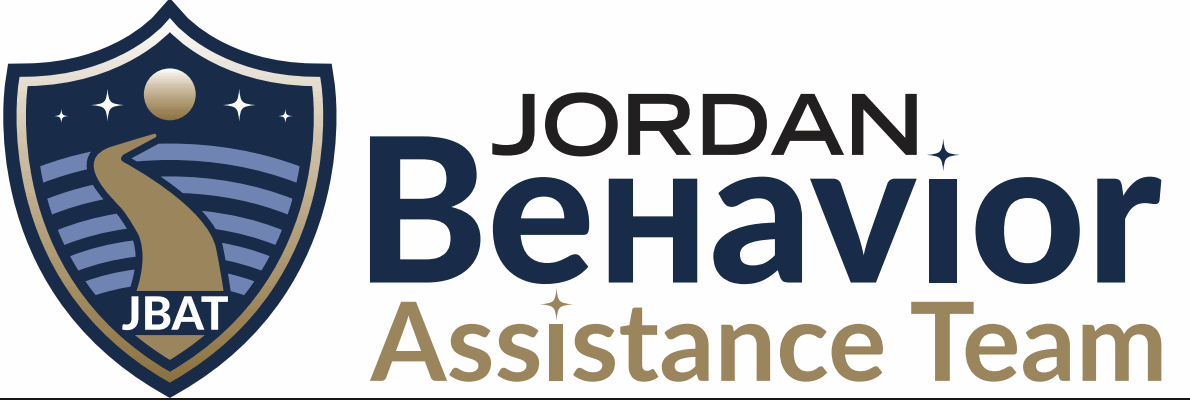Intro to the
Behavior Intervention Plan
What is a BIP?
A BIP is a Behavioral Intervention Plan, created when a students behaviors are interfering with their ability to effectively learn and participate in class. Following the process of completing a Functional Behavior Assessment (FBA), the data will be used to create the BIP; using the function and operational definition of the behavior, the antecedents and consequences of the behavior, a hypothesis statement, and a selected replacement behavior that meets the same function as a problem behavior.
1. Plan:
Using the results of your FBA, you will begin to create a plan to teach a replacement behavior to your student.
As you create a Behavior Intervention Plan, you are creating not a single strategy, but a group of strategies that will address your problem behavior and replacement behavior. All of these strategies must be used together in order for there to be a change in your student's behavior.
The BIP should include each of the following strategies:
- Setting event strategies
- Antecedent strategies
- How to prevent the problem behavior
- How to trigger the replacement behavior
- Strategies to teach the replacement behavior
- Consequence strategies
- How to reinforce the replacement behavior
- How not to reinforce the problem behavior
Create a Competing Behavior Diagram
If you have not already, we recommend using “The Competing Behavior Diagram” model to visually describe the results of your functional assessment. This will help you create interventions and strategies that align with the information you have gathered. Below you can view a sample of a Competing Behavior Diagram based on a fictional student. Click here for a downloadable copy.

Antecedent and Setting Event Strategies
Antecedent Strategies
Oftentimes, we focus most of our attention on how we respond to a problem behavior after it has happened. However, it is much more proactive to spend our attention on predicting ways to prevent the behavior from happening at all.
Antecedent strategies are changes to a student's learning environment that we can implement before a problem behavior occurs. These strategies are utilized in order to:
- Reduce the likelihood of the student engaging in the problem behavior, and
- Increase the likelihood of the student engaging in the replacement behavior
Below are some examples of commonly used antecedent strategies:
- Functional Communication training
- Emotional Regulation training
- Teach coping skills
- Use a visual timer
- Provide transition warnings
- Modify the presentation of your demands
- Provide choices proactively
- Utilize behavioral momentum
- Divide work into smaller increments
- Modify assignments to match the student's skills
- Plan a break before a difficult assignment
- Utilize visual schedules and other visual supports
- Reduce or increase the level of sensory stimulation
Setting Event Strategies
Similar to antecedent strategies, setting event strategies involve preventing a problem behavior from occurring.
A setting event refers to the context that "sets a student up" to engage in the problem behavior or makes the behavior more likely to occur. While an antecedent occurs immediately before a problem behavior, a setting event may be constantly occurring or may have occurred before the student even arrived at school. Examples include: a student sleeping poorly the previous night, experiencing a headache, arriving without eating breakfast, or experiencing an interruption in their routine.
Below are commonly used setting event strategies:
- Ensure students have eaten
- Offer water breaks throughout the day
- Allow for rest or "calm down" breaks
- Provide access to movement or sensory input
- Collaborate with the family and nurse on consistent medication schedules
- Maintain predictable routines and clear schedules
- Pair students with supportive peers or adults
- Greet students warmly and build realitonships
- Teach and practice emotional regulation skills
- Adjust task difficulty for skill level
- Provide frequent, positive feedback
- Use environmental engineering to create a safe environment and eliminate potential risks
Teaching the Replacement Behavior
The goal of teaching any replacement behavior is to make it easier and more efficient for the student to engage in that behavior than in the problem behavior. Clearly teach the replacement behavior, and positively reinforce when the replacement behavior happens. After the replacement behavior is learned, and with consistent reinforcement, the student will begin to choose it more and more frequently and it will slowly begin to replace the problem behavior.
Ways to teach a replacement behavior include:

Consequence Strategies
Consequence strategies address how you will immediately respond when the student engages in either a) the replacement behavior, or b) the problem behavior. These strategies include both reinforcement and punishment.
Reinforcing the Replacement Behavior
First, choose how your team will respond when the student engages in the replacement behavior. This will involve either positive or negative reinforcement. Reinforcement is most effective when delivered immediately after the student engages in the replacement behavior. Look back at the student's FBA for a list of their interests and preferred reinforcers.
Some ways to provide reinforcement include:
- Praise or attention
- A reward program
- An increase in privileges
- Removing a negative stimulus such as a work demand
Responding to the Problem Behavior
The team's response when the student engages in the problem behavior will typically involve removing reinforcement for that behavior. This causes the problem behavior to become ineffective in meeting the student's need.
Ways to remove reinforcement for a problem behavior include:
- Ignore the problem behavior
- Avoid engaging in power struggles
- Do not provide escape, attention, or access to tangibles that may reinforce the behaviors
- Provide clear, brief, redirections
The Power of Reinforcement
When responding to problem behaviors in the classroom, we can very easily find ourselves leaning heavily on punishments. However, research shows that it is more effective and productive to use positive reinforcement to increase a desired behavior than it is to use punishment to decrease an undesirable one. This is because punishment stops behavior but only reinforcement changes behavior.
Children who engage in problem behaviors are more likely to engage in an appropriate replacement behavior if we can make it more reinforcing to them than the problem behavior.
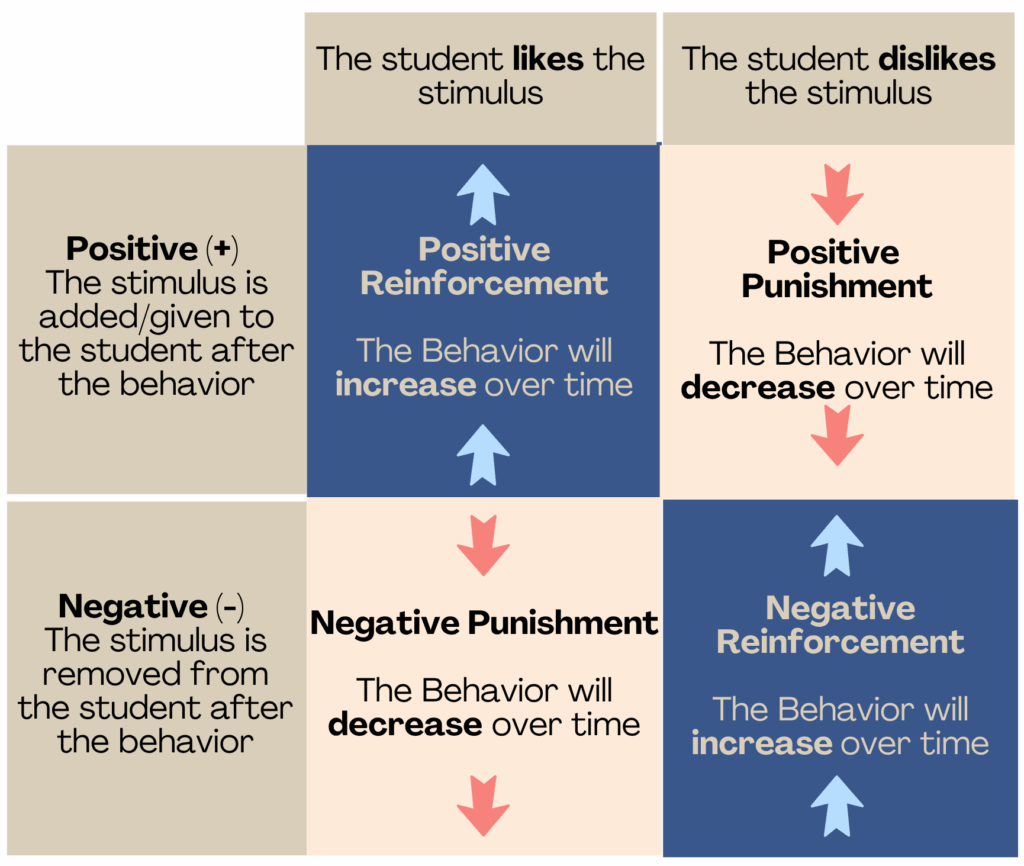
See Strategies Page Coming Soon!
2. Safety Protocol:
A safety protocol is put into place to define any requirements needed to allow the student to access school safely. This can include drop-off and pick up protocols, assigned seats, alternative tools such as safety scissors, etc. It is of utmost importance, that everyone on the team is aware of and follows through with the safety protocol. This should be explicitly written and taught to the team members and supporting school staff to help ensure safety.
Emergency Safety Interventions
If a student's behavior has been shown to necessitate the use of physical restraint or seclusion, in order to maintain safety, then the use of ESIs should be included in this section. This does imply or necessitate any future use of ESIs throughout the implementation of the student's Behavior Intervention Plan.
As stated in the LRBI, "Teams should keep in mind that ESIs are not behavior interventions and their use as a means of discipline or punishment is explicitly prohibited. Therefore, they should not be considered an intervention for problem behavior and must not be included in the interventions portion of a BIP. ESIs are only appropriate to consider in highly specific circumstances" (USBE, 2023, p. 161).
For more information on ESIs, please visit the Emergency Safety Interventions page of our website.
3. Staff Training on BIP
"Even with the best possible BIP, behavior change does not occur overnight. Teaching a new behavior requires sustained support and planned learning opportunities with just enough support for the student to be successful.” (LRBI, 158)
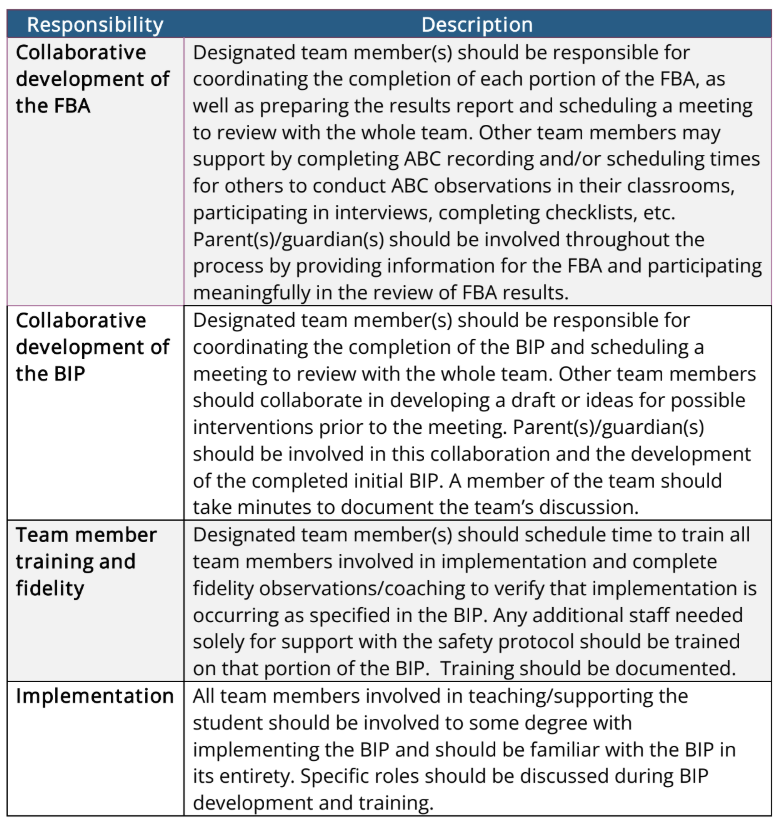
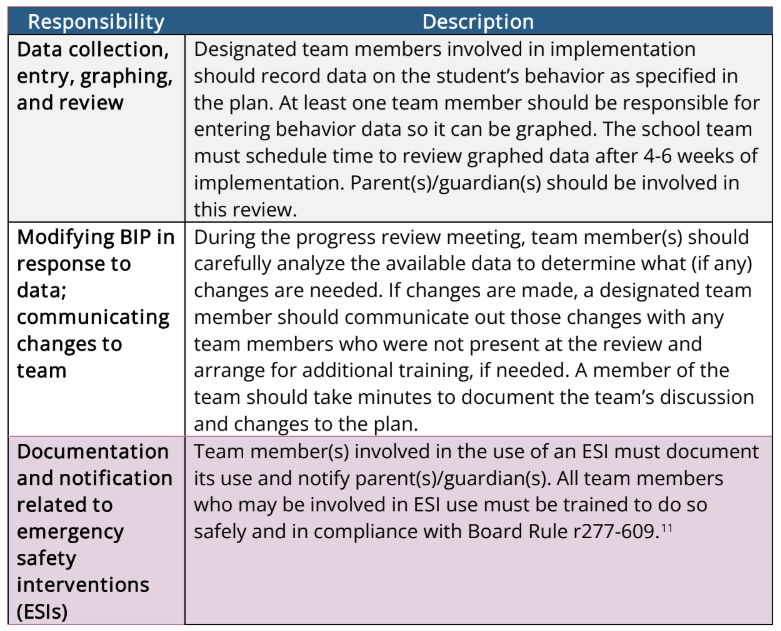
Materials and Resources
Materials and Resources for BIP Implementation
Effective BIP implementation requires preparation. Having the necessary materials and resources readily available ensures staff can apply the plan consistently and immediately, especially during critical moments.
Essential Documents
- The BIP Document: The complete, most current written BIP, easily accessible to all implementing staff (e.g., in a binder, on a shared digital drive).
- Data Sheets/Tools: Pre-printed data collection forms, tally sheets, frequency counters, or access to the digital data collection system (e.g., tablet or application). These should be easy to use and kept near the student or the setting where the behavior typically occurs.
- Fidelity Checklists: A checklist used to confirm that staff are implementing the plan's components (antecedent, teaching, and consequence strategies) exactly as they are written.
Reinforcement Resources
Reinforcement must be delivered immediately and consistently to be effective, which means having preferred items and activities ready.
- Reinforcement Menu: A visual list of the student's current preferred items, activities, or social reinforcers. This should be updated regularly.
- Token Boards/Systems: Materials needed for any token economy, such as physical tokens (chips, stickers), the token board itself, and a visible collection of back-up reinforcers the student is working for.
- Tangible Reinforcers: A small, easily accessible collection of preferred items (e.g., fidget toys, special pencils, small treats) that can be delivered quickly.
- Access to Activity Reinforcers: Clear procedures for accessing preferred activities (e.g., computer time, helping a staff member, quiet reading spot) when earned.
Instructional and Environmental Resources
These resources support the teaching of the replacement behavior and modifying the environment.
- Visual Supports: Laminated visual schedules, first/then boards, choice boards, and social narratives that prompt the replacement behavior or help the student understand expectations.
- Sensory Tools: Specific sensory items (e.g., weighted blanket, stress ball, chewable tube, movement breaks) identified in the BIP to help the student self-regulate.
- Environmental Adjustments: Physical materials needed to modify the classroom or workspace, such as a privacy screen, a designated quiet corner, or a seating arrangement that minimizes specific triggers.
Team Members and Roles
Responsibility for Gathering BIP Materials
While many people may contribute items, the overall accountability usually falls to a central point person:
1. Primary Accountability: The BIP Coordinator / Case Manager
The Case Manager (typically a special education teacher, school psychologist, or counselor) is responsible for the BIP process from the Functional Behavior Assessment (FBA) through the review. Therefore, they are ultimately responsible for:
- Creating the Master List: Generating a complete list of all required documents, instructional aids, sensory tools, and reinforcers outlined in the BIP.
- Delegating Tasks: Assigning specific item collection to the appropriate staff members (see below).
- Organizing and Storing: Ensuring all materials are organized, readily accessible to the implementing staff, and that data collection tools are distributed.
- Budgeting: Coordinating with the administration to secure funds for specialized or purchased materials.
2. Contributory Roles (Shared Responsibility)
Other team members have specific roles in gathering and maintaining certain types of resources:
- Classroom Teacher/Implementing Staff: They are responsible for gathering and maintaining classroom-based resources, such as the student's visual schedule, the data sheets/tools used daily, and ensuring the reinforcement menu is current and stocked with low-cost, readily available items (e.g., pencils, stickers, classroom activities).
- Parents/Guardians: They may contribute valuable information and sometimes certain highly preferred, personal tangible reinforcers that are not easily acquired by the school. They are also key to ensuring consistent implementation between school and home.
- Behavior Specialist/School Psychologist: They often gather or create the specialized instructional materials, such as social narratives, complex visual supports, and fidelity checklists.
- School Administration: They are responsible for the budget allocation to purchase necessary, higher-cost items like specialized sensory equipment or software licenses for digital data systems.
In short, the Case Manager tracks everything, but the staff who interact with the student daily are responsible for having their specific materials ready to go.
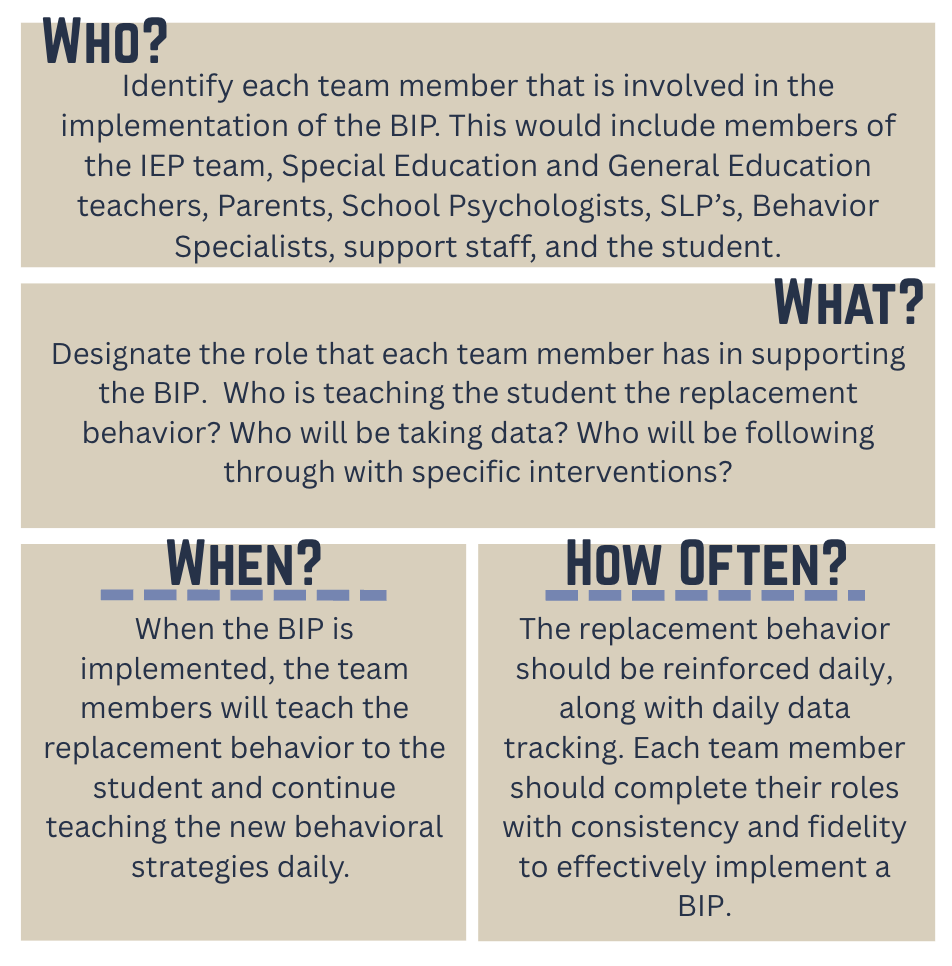
Data Collection
Data collection is critical for successful Behavior Intervention Plan (BIP) implementation. Data should be taken continuously during the intervention to ensure the plan is working as intended and driving the desired behavior change. You take data by systematically tracking the target behavior, its antecedents (what happens before), and its consequences (what happens after), as outlined in your BIP. Consistent, accurate data collection provides the objective evidence needed to evaluate the plan's effectiveness. If the data shows the behavior is not improving, it signals that the BIP needs to be modified or adjusted to better meet the student's needs.
See the Data Collection page for more information and examples on taking data.
4. BIP Review:
Reviewing and Revising the Behavior Intervention Plan
A BIP is not a static document; it is a fluid tool that must be reviewed and revised regularly to remain effective. This process is driven entirely by the data collected during implementation.
When to Review the BIP
The frequency of BIP reviews depends on the student's needs and the plan's initial success.
- Initial Review (The "Check-In"): Conduct a brief review 2 to 4 weeks after implementation begins. This allows the team to confirm the plan is being implemented with fidelity and that initial data trends are positive.
- Scheduled Reviews: Formal reviews should be scheduled periodically (e.g., every 6-9 weeks, or at the end of a marking period) as part of the student's regular IEP or support meetings.
- Immediate Review (The "Warning Sign"): An immediate review is necessary if the data shows the target behavior is worsening or no meaningful progress is being made over a defined period (e.g., 4 consecutive weeks).
How to Conduct the BIP Review
The review should be a collaborative, data-driven process involving all key stakeholders (teacher, support staff, parent/guardian, administrator, and student, if appropriate).
- Review Implementation Fidelity: Confirm that all adults are implementing the BIP procedures (antecedent strategies, teaching new skills, consequence strategies) exactly as written. Inconsistent implementation is the most common reason for failure.
- Analyze the Data: Systematically review the graphed data. Is the frequency, intensity, or duration of the target behavior decreasing? Is the functionally equivalent replacement behavior (FERB) increasing?
- Identify Hypothesis Validity: Based on the data, determine if the function of the behavior, as identified in the Functional Behavior Assessment (FBA), is still accurate. A lack of progress may indicate the initial hypothesis of the behavior's function was incorrect.
What to Do After the Review (The Decision)
The review will lead to one of three possible decisions:
| Data Trends Show... | Recommended Action (What to Do) | Focus of Revision |
| Clear, sustained progress (Behavior is decreasing) | Maintain and Fade: Continue the BIP, but begin to plan for fading the intensity of supports (e.g., fewer prompts, less frequent reinforcement) to promote independence. | Plan for Generalization and Maintenance. |
| Minimal or slow progress (Behavior is flat/slightly decreasing) | Modify and Intensify: Make specific, targeted changes to the plan. This might mean increasing reinforcement rates, teaching a more effective replacement skill, or adjusting the antecedent strategies. | Refine Teaching Strategies or Reinforcement System. |
| No progress or worsening (Behavior is increasing) | Re-assess and Revise: The current plan is not working. The team must return to the FBA process to re-verify the function of the behavior and create a substantially new BIP. | Review the Function Hypothesis and create new strategies. |
